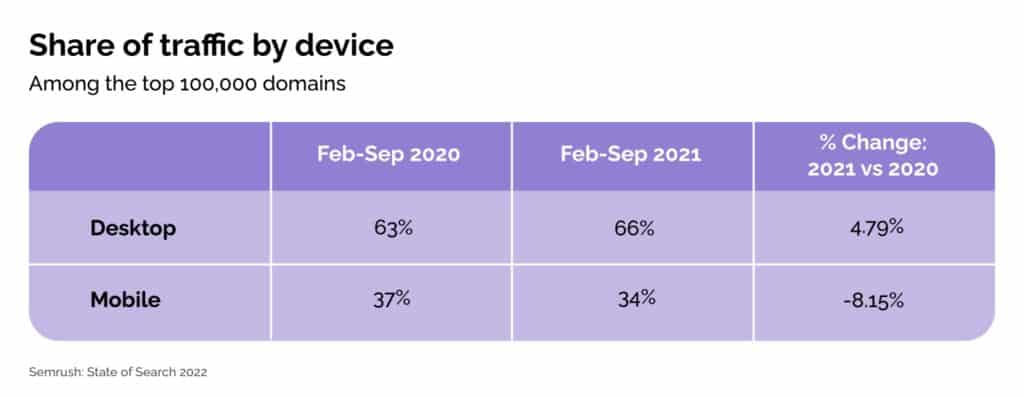Search engine optimization (SEO) plays hard to get. Optimizing your brand’s website for search visibility can feel a bit like chasing down that person you wanted to date in college. You’ll ask yourself some questions repeatedly: Do they (meaning: the search engine) like me? Are they interested in what I have to say? Am I showcasing my best attributes? Do they think that I’m a catch?
Here’s the good news: we’re here to help you figure out SEO trends for 2023, and we brought the data to back it up.

Think of us as your wingman (or wing woman), here to give you the SEO predictions you need so you can win your prospects’ attention with proven search engine strategies and tips. We’ll decode the data and hidden messages about the changes to search engine optimization and uncover the top SEO trends that help you reach your ideal customers.
Semrush’s recent analysis of the state of search in 2022 revealed that major changes are happening in the SEO world. Their annual report shows us the numbers behind SEO successes (and SEO failures) in the digital space. But it’s a lot of data, so let our experts decode it for you.
Here are the top twelve tips and how you can apply them to improve your overall SEO strategy for 2023 and beyond.
12 SEO Trends to Improve Your Strategy in 2023
1. Don’t spend all your marketing money on paid ads.
If you’re reading this blog, the chances are high that you’re wondering how you can make your marketing dollars go further. If that’s the case, then don’t spend all of your marketing money on paid ads. While this may seem like a no-brainer, too many companies devote all of their marketing budgets to paid advertisements.
The data says that this might not be as effective. According to the Semrush report, search ads (essentially any paid advertisement that’s meant to show up on the results page of a search engine) showed up less frequently in 2022 than in 2021. Here’s what this means for brands: Paying to get your website ranked on one of the top search engine results pages may not be the best use of your money. If those ads appear less frequently across the board (as indicated by the research), their effectiveness decreases. If you’ve devoted all of your marketing tactics to paid ads and neglected your organic search initiatives, it’s time to rethink.
2. Keep investing in mobile and desktop web development.
“Mobile first!” Marketers have been shouting that message from the rooftops for years, but does it still hold true? Apparently not. Data shows an 8% year-over-year decrease in mobile traffic. This directly contradicts the “mobile-first” message marketers have been touting for years. On top of that, desktop traffic has been on the rise since 2020. So what does this mean for you? Should you abandon your mobile-first approach? Not necessarily. This metric shows us that it’s important to invest in both sides of your digital marketing strategy—mobile and desktop—to ensure that your users’ experiences are positive across the board. With so many leaders promoting the mobile-first method, some brands let their desktop experience lapse. It’s time to revamp.

3. Most e-commerce traffic isn’t organic.
If you’re an e-commerce brand, you might want to invest a little more in marketing and adjust your strategy as buyers return to a normal purchasing process in a post-pandemic world. According to a survey by the Search Engine Journal, 20% of respondents saw an increase in their organic marketing budgets in 2022. Another 86% of organizations surveyed said they expect to increase their organic marketing budget next year. And if you want to support your organic traffic, ultimately leading to conversions, you’ll need SEO to support it. This is great news for companies looking to capitalize on SEO techniques and trends in 2023.
Related reading: 4 Effective B2B eCommerce Marketing Strategies
4. Companies are investing in organic marketing.
What is “informational SEO?” It’s a way of classifying top search queries by their intent. Semrush breaks search queries into four categories: informational, transactional, navigational, and commercial. Informational search queries rank at the top. This means that internet users are searching for information more than half of the time, and they want answers to key questions or data and insight about a particular issue.
This is critical information about B2B buyer behavior. Marketers and brands should take note. As you’re assessing your company’s website for effectiveness, look at the information you share. Have you answered frequently asked questions? Do you define or clarify the nuances of your industry, product, or services? These pieces of basic information can help you win traffic and engage your prospects.
5. Focus on informational SEO.
What is “informational SEO?” It’s a way of classifying top search queries by their intent. Semrush breaks search queries into four categories: informational, transactional, navigational, and commercial. Informational search queries rank at the top. This means that internet users are searching for information more than half of the time, and they want answers to key questions or data and insight about a particular issue. This is critical information about B2B buyer behavior. Marketers and brands should take note. As you’re assessing your company’s website for effectiveness, look at the information you share. Have you answered frequently asked questions? Do you define or clarify the nuances of your industry, product, or services? These pieces of basic information can help you win traffic and engage your prospects.
6. People want answers to questions and information.
On a related subject, one of the biggest findings of the Semrush research is related to user intent. Not only does informational SEO have the highest search volume, but it also supports the notion that internet users are motivated by the search for information. We’ve already discussed the importance of answering critical FAQs or providing basic information, but this data should influence your strategy at a higher level as well. Every brand should be creating content to boost its website ranking, improve its reach, and serve its customers. However, some types of content are more beneficial than others. Based on this recent data, educational content will be most impactful for your brand.
Look at your existing B2B content marketing strategy across channels (from your website to social media accounts) and determine what kind of approach you’ve taken. Do you provide educational resources? Are you equipping your audience and prospects with the information they need to understand your industry, offerings, or services? If not, it’s time to make a switch, and an educational content strategy will help you build trust with your readers and grow your audience. Be sure to incorporate this strategy into your B2B social media marketing strategy, your blogs (yes, you should be writing regular blogs for your company website!), and the copy on your website.
7. Short search queries are more common.
Another very specific SEO tidbit: Most users prefer short search queries. The data shows that 67.1% of searches use three to five words in total. One key note that Semrush makes is the impact of the “People Also Ask,” “People Also Search For,” and “Related Searches” features. Think about the last time you searched for something online. Did the second half of your search question pop up in a drop-down menu below the search bar? That’s the related search feature helping you figure out which question you’re asking and providing you with that information more quickly.
Keep these short search queries in mind as you’re working through your B2B SEO strategy. Since shorter phrases are more commonly searched for, experiment with shorter keyword phrases throughout your website. Overall, the data shows that keyword phrases are most impactful when they are five words or fewer.
8. Voice search is gaining traction
As virtual assistants become more prevalent, optimizing content for voice search is becoming increasingly important. To do this, businesses should focus on long-tail keywords and natural language queries that match the conversational tone of voice search. Additionally, they can create content that answers frequently asked questions that users might ask when using virtual assistants like Siri or Alexa. Finally, it’s important to consider featured snippets, which often provide the answers to voice search queries.
9. Mobile-first indexing
Google has already implemented mobile-first indexing, which means that it’s essential for businesses to ensure that their websites are optimized for mobile devices. This includes having a responsive design that adapts to different screen sizes, fast loading times, and easy navigation on smaller screens. Google will prioritize mobile-friendly websites in its search engine rankings, so it’s crucial for businesses to make sure that their websites are up to par.
10. User experience will always be king
User experience (UX) will always be more important than ever for SEO. Google is prioritizing websites that provide a good user experience, which means that businesses should focus on improving their website speed, navigation, and mobile responsiveness. Additionally, they should ensure that their content is high-quality and relevant to their users’ needs. Providing a positive user experience can help increase engagement, lower bounce rates, and ultimately drive more traffic to a website.
11. Featured snippet wars are real
Featured snippets are a type of search result that appears at the top of Google’s SERPs. These snippets provide a brief summary of the content on a website and often include a link to the full article. By optimizing content to appear in featured snippets, businesses can drive more traffic to their websites. To do this, they should create high-quality, informative content that answers users’ questions in a concise and clear manner.
The “featured snippet wars” refer to the competition between websites to appear in the featured snippets section of Google’s search engine results pages (SERPs). A featured snippet is a summary of an answer to a user’s search query, displayed at the top of the search results, often above even the top-ranking organic result.
12. Utilize schema markups
Schema markup is a way to provide search engines with additional information about a website’s content. By adding structured data to a website, businesses can improve their search engine rankings and provide users with more relevant search results. Schema markup can be used to provide information about a website’s products, services, and organization, as well as events, reviews, and other types of content. By providing search engines with more detailed information about a website’s content, businesses can improve their visibility in search results and drive more traffic to their website.
These twelve trends show us the nuances of consumer behavior and how search engine algorithms impact the reach of our brands. It’s essential to understand how consumers are behaving so that you can understand how to reach them. Remember: The function of SEO is to get your message out to your intended audience. Stay focused, implement these data-based strategies, and watch your brand reach grow.
And, if you’re ready to bring in the experts, you know who to call.



